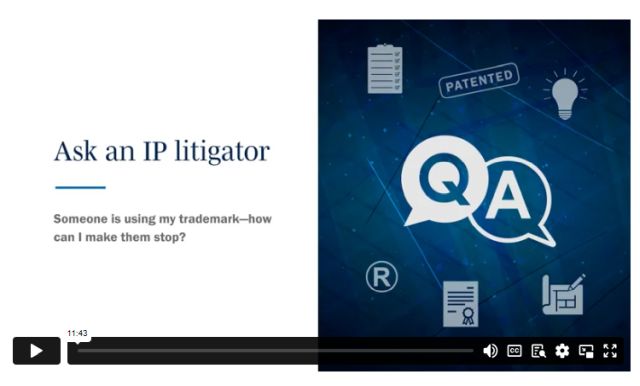- within Insolvency/Bankruptcy/Re-Structuring topic(s)
- with Senior Company Executives, HR and Finance and Tax Executives
- with readers working within the Banking & Credit and Healthcare industries
Video transcript
Emily Sherkey (00:05): What happens when you've designed a name and logo and have spent a lot of money marketing your brand, and then you see another company using an identical or similar mark? It may be that someone is intentionally selling a counterfeit version of your goods, or it may be that someone without bad intentions simply designed and began to use a trademark that's similar without knowing.
Either way, the same question springs to mind: What happens next and how can I make them stop? I'm Emily Sherkey, and I'm here with my colleague, Michelle Nelles, to answer that question.
If a company notices an identical or similar trademark being used, what's the first step they can take?
Michelle Nelles (00:53): Well, Emily, the first step is then to determine if there actually is a violation of your trademark rights. Now, the test for whether a trademark is infringing another or is likely to be confused with another is whether there's a likelihood of consumer confusion. It doesn't mean that the marks have to be identical, but it's whether the average consumer would be confused as to the source of the goods.
It's not an actual confusion test where you need to have evidence of actual confusion already.
Emily Sherkey (01:23): What are the factors that you would consider?
Michelle Nelles (01:25): So, there are a number of factors. The first would be: Do you have a registered trademark? If you have a registered trademark, you have broader rights in that you will have the right to use that mark throughout Canada and it won't matter where you are actually carrying on business. For example, if you only carry on business in Ontario but you have a registered trademark, then as far as stopping someone in B.C., you know that that's very possible.
You don't have to prove that you also have a reputation in B.C., which would be the case if you have an unregistered trademark. So, I'm not saying that you can't do anything if you have an unregistered mark, because we do have protection for that. But, you know, the first kind of question to ask is, is the trademark registered or not?
But location something to think of. And then you're also going to want to think about the similarity of the marks, of course, because that's kind of the starting point of the confusion test is how similar are they in appearance and in meaning and in sound? You also will need to consider the nature of the goods, the nature of the business, the channels of trade.
In other words, how are the products or services provided to consumers? And then the other thing that you'll want to consider is how unique your mark is. And what I mean by that is like a coined, very distinctive word will generally have broader protection, whether it's very descriptive, like if it describes the goods and services or not. And also whether your mark is famous, you know, if you've used it for a really long time and everyone knows it.
Emily Sherkey (03:01): You've assessed the situation and you and your lawyer believe that this trademark is confusingly similar to yours. What's next?
Michelle Nelles (03:11): Well, it's really important if you have come to the conclusion that there is an issue here, that you do something about it. Because the whole premise of a trademark, of course, is that it's distinctive of one source. So, if there are more than one unauthorized user, and what I mean by that is if you've licensed somebody to use it, that's different.
Michelle Nelles (03:34): But you know what? An unauthorized user using on the market, if you don't do anything about it, that can destroy the distinctiveness of your mark. And over time, frankly, your trademark rights can be invalidated and definitely eroded. So, the first thing I think you'll want to do is you'll want to send a letter, a cease and desist letter, to the company or the party, and that will, you know, kind of generally set out your rights and ask them to stop.
Now, it's not, of course, mandatory that you send a cease and desist letter. You could jump right out into litigation. But, you know, we definitely recommend it. You know, I don't see a downside to doing it. And sometimes, many times, it's possible the infringer, you know, didn't know or doesn't have the budget or the wherewithal to want to fight.
And so, you know, potentially you could get the matter resolved in your favor without resorting to litigation, which is obviously best case scenario. Emily, if the letter doesn't work, it'll also serve as useful evidence in a lawsuit that you tried to enforce your rights. And it'll show that you were trying to negotiate in good faith with and courts always like you to, you know, come to them looking like you've been trying to resolve things, you know, on your own.
Emily Sherkey (04:51): And so, Michelle, should clients write their own cease and desist letters?
Michelle Nelles (04:56): Well, sometimes it can be impactful to have a cease and desist letter on a law firm letterhead. So, you know, there may be situations where you definitely want a law firm involved. Now, there's no reason why a company in certain circumstances cannot send one. But what we would recommend is that the content, of course, be either drafted by or vetted by a trademark lawyer, because you just want to make sure that you have the right words in the in the cease and desist letter.
So, Emily, what will the next steps be if unfortunately, your cease and desist letter doesn't get resolved, then what would the next step be for the client?
Emily Sherkey (05:35): Unfortunately, the answer is to sue, which I know many clients and companies don't want to have to find themselves in litigation. But if you've sent the cease and desist letter, you've sent a follow up. And the company, the infringer is just not stopping using or infringing your trademark rights. Your only option to protect yourself is to sue.
Before suing, you should be asking yourself the question of whether you are using your own trademark rights. This may not be a problem if the trademark in question is your brand and you're using it and marketing with it all the time. But perhaps you had a different mark that you developed that you've used as a short-lived promotional campaign and you haven't used it in years, but you want to pull it out again, or you want to have the option to pull it out again in the future. That's where you might run into a problem.
But assuming it's a trademark you use and you want to protect, your option is to then sue, often not always in the federal court. And the remedy you're going to seek is a permanent injunction, which means you're going to ask the court to tell them to stop using it for good.
And you're also likely going to seek compensation for the harm you suffered for the time they had used the mark until they've been ordered to stop.
Michelle Nelles (05:53): Right. And as we know, lawsuits can take a really long time, often years, to get to a trial. And because of that massive kind of delay, what can a client do if they think that they are going to be in a really bad position, if that party is out in the marketplace for 2 to 3—or however long it takes—years to get to a trial for a final kind of resolution and hopefully a permanent injunction then?
Emily Sherkey (07:23): You're absolutely right, Michelle. Trials take years to get to. You can try and make it expedited, but you're certainly looking at 1 to 2 years, even in an expedited forum. And in that time, the infringer is using your trademark. And so, what you can do is go to the court and ask for interim relief. We call this an "interlocutory injunction".
And basically you're going to the court and you're saying, "It's going to take years to get to trial. Between now and then, I need them to stop using the mark and stop confusing consumers in the marketplace through this period of time." It's very hard to get an interlocutory injunction. It's pretty extraordinary relief. And you have to prove, among other things, that you have suffered irreparable harm, which means harm that cannot be compensated for in damages.
So historically, to do that is very hard. Companies on the other side—the infringers—would say, "If consumers are confused and they buy my goods instead of yours, then that's lost sales. So, we can quantify that, and that can be an order for damages." So, it was very hard to prove that you have suffered something that can't be compensated for.
Emily Sherkey (08:36): However, in 2017, the Federal Court granted an interlocutory injunction for Sleep Country in its trademark case against Sears. Sleep Country has the jingle, "Why buy a mattress anywhere else?" I will not sing it for the sake of everyone watching. But Sears began to use the slogan, "There is no reason to buy a mattress anywhere else." Sleep Country brought a trademark infringement case, and they brought expert evidence to seek an interlocutory injunction to stop Sears from using that slogan—that trademark—before the case went to trial.
And they got it. And commentators have suggested that this Sleep Country verdict could open the door to more interlocutory injunctions and trademark cases. Because in a trademark case, you're always facing a lack, a harm to the distinctiveness and goodwill of your brand. We haven't seen a huge amount of interlocutory injunction cases since Sears and Sleep Country, a couple.
It kind of remains open how easy it will be. I still think it's going to be hard to get. Sleep Country was pretty unique facts and they brought expert evidence. But if you have a counterfeit case, if you have a case with trademarks that are very similar, and even if you don't, you should always be looking at the option of getting this relief and asking the question of whether or not you should be bringing a motion for it.
The other thing to keep in mind, to get this relief you have to act quickly if you are aware of the other side using your mark and you sit on it for months and months, it may make it very hard to get an interlocutory injunction.
Michelle Nelles (10:14): So, in summary, the first step you should take ideally is to register your trademark. As we said, there are better protections essentially available if you have a registered trademark. Now, if you come across an infringer in the marketplace and you don't have a registered trademark, as we've mentioned earlier, it's not like you can get a registration and then go after them because it takes a long time to get a registration and there is the ability to stop based on your common law right, but that just has to be investigated.
But just kind of first step is ideally, if you have a registered trademark, then that's great. If you're concerned that there is a confusingly similar trademark out there in the marketplace, as we've highlighted, it's really important to take active steps to stop that party from continuing. If you don't, potentially it can lead to eroding, a decrease in the value of your trademark. Potentially over time, even losing your trademark—the validity of your trademark—and hopefully a cease and desist letter will do the trick.
And that obviously is what most people will desire rather than resorting to a lawsuit. But, if unfortunately, a result is not obtained by a cease and desist letter, then a lawsuit may be an option. And potentially, as Emily said, investigation of an interlocutory injunction just to protect your trademark rights.
Trademarks protect your brand and are a crucial part of an intellectual property strategy. So, what happens if someone is using an identical, or similar, trademark?
In this video, Emily Sherkey and Michelle Nelles discuss what you can do if you suspect someone is violating your trademark rights, including:
- assessing potential violations
- steps to stop an infringer, from cease and desist orders to interlocutory injunctions
The content of this article is intended to provide a general guide to the subject matter. Specialist advice should be sought about your specific circumstances.



